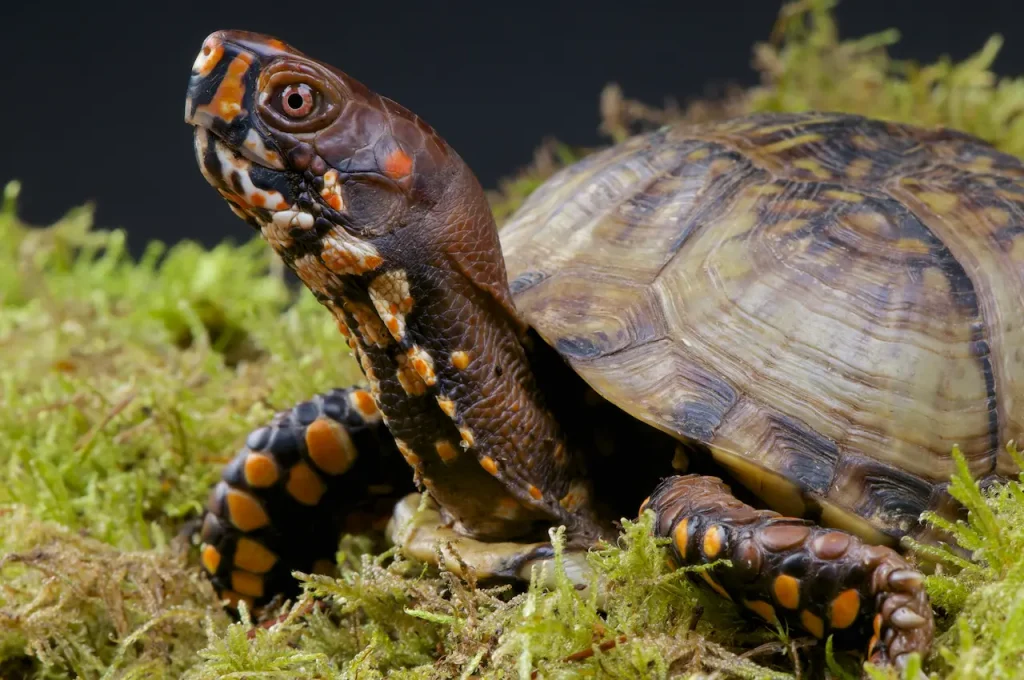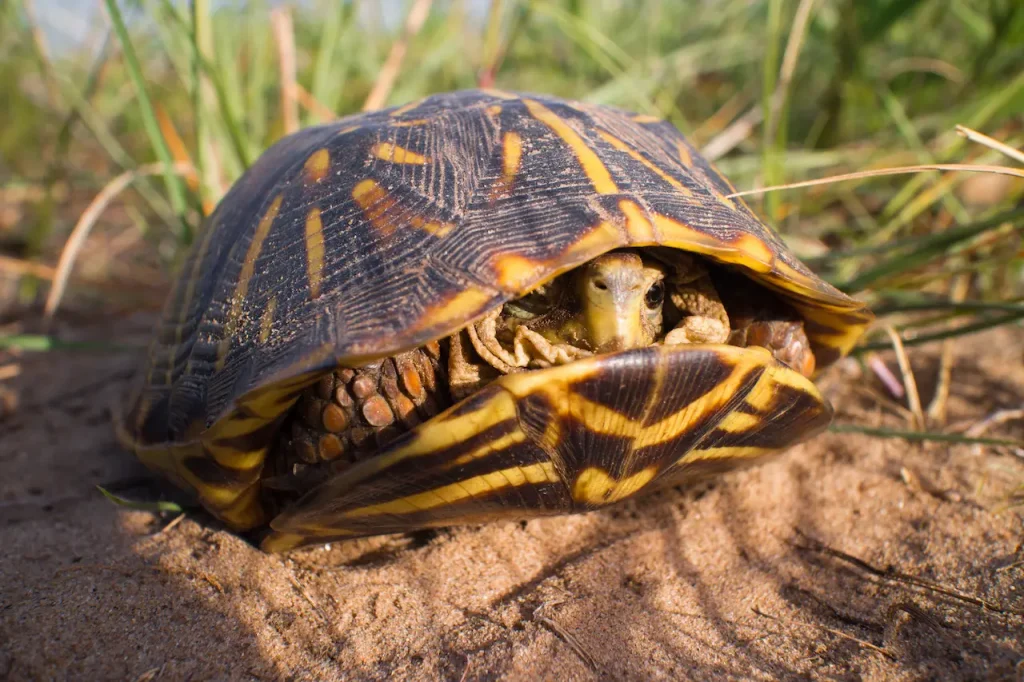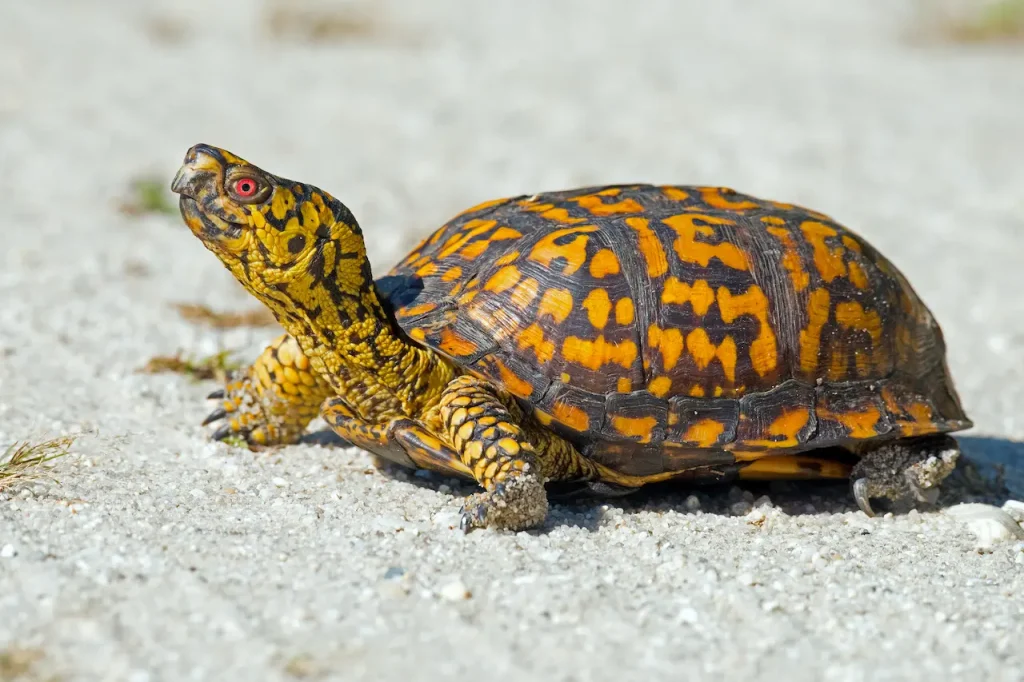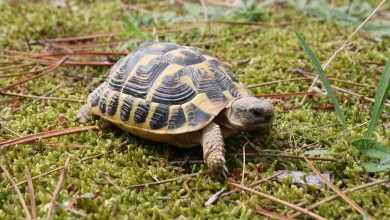Box Turtle Care Sheet
Have you inadvertently found yourself with a new pet box turtle, or you’re searching and wondering if one might make the right pet for you?
Unfortunately, this species doesn’t tolerate frequent handling well, and they’re sensitive to dietary deficiencies and improper husbandry practices, so they don’t make the best pets for beginners or young children.
However, box turtles make interesting, interactive pets for the right people who are experienced or willing to invest the time, effort, and research required to care for this species.
Table of Contents

Box Turtle Background Information
Box Turtle Species Information
What is a Box Turtle?
Box turtles are small, terrestrial chelonians native to many parts of the United States and Mexico. They thrive in a wide variety of habitats in the wild, from woodlands to grasslands, to deserts.
Box turtles’ appearance generally varies from species to species and subspecies to subspecies.
The following are all species of Box Turtles:
- Species 1
- Species 2
- Species 3
- Etc.
They grow up to be 4 to 8 inches long, and their large, domed carapace (top shell) and appendages usually feature intricate yellow or orange patterns on a black or dark brown background.
Box turtles are uncommon as pets, and their care is complex, but hobbyists who are drawn to them appreciate their small size, terrestrial care requirements, personability, and long life span.
In the wild, the average lifespan of an adult box turtle is 50 years! Many individuals even live to be over 100 years old.
Unfortunately, most box turtles kept as pets do not live such a long life because their caretaker isn’t familiar with their turtle’s needs. Luckily, you’ve come to the right place to avoid this issue.
We’ll put you on the right path to ensure that your pet lives a long, healthy life!
Quick Facts Table
The Basics – Where to Buy a Box Turtle
You may have noticed that you haven’t seen any box turtles for sale at your local pet store, or even at the reptile expo.
There are several reasons why box turtles are a bit harder to find for sale than, say, bearded dragons or red-eared sliders.
The primary reason is that many box turtle species are threatened or endangered in their native ranges, and there are legal protections in place to prevent collection from the wild. This is a good thing!
EXPERT TIP? You should never knowingly purchase a wild-caught box turtle – always go for a captive-bred animal from a reputable source.
Box turtles are also slow to reach maturity, and even once they reach adulthood, a female will only produce 1 to 7 eggs per year. Most animal breeders prefer to focus on species that grow and breed quickly.
Finally, most box turtle species become incredibly stressed if they are removed from their original territory. Some animals may wander aimlessly, trying to find their original home, refusing food, until they become weak and sick. This can make re-homing adult and sub-adult boxes tricky.
Still, a few hobbyists are dedicated to sustaining the captive population of most box turtle species, allowing any enthusiast to own the box turtle of their dreams!
You’ll most likely have to purchase your new pet online, from a reputable breeder. It’s wise to choose a young animal between 6 and 12 months of age, as opposed to a brand-new hatchling, if that choice is available. Very young boxes are fragile.
Depending on the species you’d prefer, you can expect to pay between $100 and $450 for a box turtle, not including shipping. As live animals, they need to be shipped overnight, which typically adds another $50 to $100 to the total cost.

Box Turtle Diet & Feeding
Box turtles are omnivores that require a varied diet of protein, vegetables, and fruit.
Given the wide variety and sometimes exotic nature of the food they need, you can expect to pay around $50 per month for your box turtle’s diet. This price can, of course, be reduced or increased based on any sales, bulk purchasing, organic products, and special treats you may choose.
In the wild, they mainly feast on protein sources: insects, carrion, eggs, young rodents and birds, and smaller amphibians and reptiles – whatever they can catch. In captivity, insects and any non-whole protein sources should be supplemented with calcium powder. Never feed processed meat products.
Most vegetables and fruits, including leafy greens and grasses, are great, healthy choices for boxes.
In fact, the list of plant matter you shouldn’t feed them is shorter than the list of foods you can provide them! In any case, always avoid:
- Rhubarb
- Tobacco leaves
- Tomato leaves
- Potato leaves
- Avocado skins or pits
- Poison ivy and other irritating plants
The overall calcium-to-phosphorus ratio of their diet should be between 1.5:1 and 2:1. You can accomplish this using a calcium powder supplement, a whole cuttlefish bone left in the enclosure, and utilizing high-calcium fruits and vegetables.
Any hard or tough food items should be shredded or chopped into small, bite-size cubes.
What their Diet Consists of:
- Protein Sources
- Live feeder insects such as earthworms, crickets, roaches, and black soldier fly larvae.
- Canned or freeze-dried feeder insects such as grasshoppers, snails, and shrimp.
- Small lizards, insects, and other invertebrates from your yard, only if your yard is pesticide-free.
- Frozen, thawed feeder mice and chicks.
- Cooked eggs, meat, and organs such as poultry, beef, pork, and fish.
- Soaked dry dog food or commercial turtle diet.
- Vegetables
- Squash (Summer and Winter squashes)
- Winter squashes are usually higher in calcium
- Celery
- Radishes
- Peas
- Sweet potatoes
- And many more!
- Squash (Summer and Winter squashes)
- Leafy Greens
- Collard greens
- Mustard spinach
- Turnip greens
- Dandelion greens
- Kale
- Spinach
- Cabbage
- And many more!
- Fruits
- Papayas
- Oranges
- Raspberries
- Apples, with skin
- Bananas
- And many more!
- Vitamins and Minerals
- Calcium powder
- 2-3x per week
- Achieve 1.5:1 to 2:1 ratio of calcium: phosphorus
- Reptile multivitamin
- 2-3x per week
- Helps avoid Vitamin A deficiency
- Full-spectrum UV lighting
- 10-12 hours per day
- Calcium powder
How Their Diet Varies Based on Age
Box turtle diet varies considerably based on the age of the turtle.
Adult boxes should eat a diet that consists of approximately 50% proteins, 30% non-leafy vegetables, 10% leafy greens, and 10% fruits.
Young box turtles under 12 months of age eat an almost entirely carnivorous diet. They need high amounts of protein, fat, and calcium for healthy bone and shell growth. As they get older, baby box turtles will gradually start eating more and more plant foods.
However, it’s still important to offer them a large assortment of vegetables and fruits with each meal. This will help your youngin’ become familiar with the sight, scent, and taste of healthy, vitamin-packed plant foods. It also gives them the freedom to start eating these foods whenever they feel the urge, craving, or readiness.
Feeding Schedule: How Often to Feed to Feed Them
Just like diet composition, feeding frequency varies based on the age of your turtle.
Babies
Baby box turtles should be fed once a day until they reach 12 months old. Each meal should include as much protein as your little turtle is willing to eat, along with a small “side salad” of new fruits and veggies for them to try while they gradually adjust and prepare for an adult diet.
Adults
Adult box turtles can be fed as often as every other day, or as infrequently as every three days.
The meal size and frequency should be based on your pet’s appetite, activity level, and the weather and season. Many box turtles will slow down or stop eating entirely in Winter. Avoid allowing their ambient temperature to get cool enough to trigger hibernation.
Some box turtles do become overweight. Obesity may be avoidable by only offering low-fat protein sources. Pinkie mice, beef, pork, fish, and certain grubs are all unnecessarily high in fat. The most apparent sign of obesity in turtles is the inability to draw themselves into and “close” their shell completely.
Box Turtle Habitat & Tank Setup
Possibly the most crucial first step in planning your box turtle’s enclosure is whether you will be keeping them indoors, outdoors, or both based on seasonal temperature suitability.
Most box turtle owners keep their pets in outdoor enclosures. This allows the animal to engage in natural foraging behaviours, absorb natural UV light, and experience the enriching weather changes, sights, sounds, and smells of the outdoors.
On the other hand, indoor enclosures are better suited for keeping your box turtle safe from potential predators, including foxes, coyotes, rats, large birds of prey, stray dogs and cats, and wild snakes. They’re also better if you happen to live in a climate that gets frigidly cold in the Winter.
Size of the enclosure
Being foragers by nature, box turtles will appreciate and utilize any and all the extra space you can afford to give them.
Minimum enclosure dimensions are dependent on the species you are keeping, but 36”x18” is considered the minimum acceptable size.
Box turtles aren’t climbers, but they are burrowers, so you’ll want to make sure your enclosure is tall enough to allow for 3 inches of substrate and 18 to 24 inches of wall, so your little guy won’t ever be able to climb out.
Type of Enclosures
Outdoor enclosures are usually constructed out of wood walls, with fencing lining the top and bottom of the habitat. You’ll want to construct a sturdy wire “lid” that allows natural sunlight in but prevents potential predators from entering, too.
Unless you build an enclosure with a solid floor, fencing or wiring needs to be buried 3 to 6 inches under the ground level, since box turtles love to dig and burrow. You wouldn’t want them digging an escape route!
Indoor habitats are typically created using commercially available glass or acrylic aquariums. If you go this route, use a visual barrier everywhere that is at eye level (or below) with your box turtle. They’re not capable of understanding the concept of a see-through wall, and their mission to go through these invisible walls is stressful and detrimental to their health.

Ideal Temperatures
Like most reptiles, your box turtle should have the ability to thermoregulate inside their enclosure. Boxies prefer ambient temperatures ranging between 70°F and 90°F, and a basking surface temperature of 85-90°F.
To facilitate this, you must devise a warm side and a cool side in their habitat. This is called creating a temperature gradient.
Temperatures are much easier to track and control in an indoor enclosure. Outdoors, things might fluctuate a little more. There will be hot days; there will be cold days; there will be rainy days. It’s okay! That is all-natural. As long as the climate where you live is suitable for box turtles, things should be fine.
Be sure to offer plenty of exposed, flat rocks and logs that will allow your turtle to climb up and closer to the sun or artificial heat source. Also, provide a damp, deep substrate for burrowing, a shallow, wide water dish for soaking, and plenty of shaded areas that your box turtle can use to cool off.
You can use a heating element for indoor enclosures, such as an incandescent bulb, halogen bulb, ceramic heat emitter, or radiant heating panel, over half of the pen. Always use a thermostat to avoid overheating your turtle.
Lighting
If your box turtle’s enclosure is outside, there’s no need to worry about supplemental lighting.
For indoor box turtles, full-spectrum UV lighting is essential for Vitamin D synthesis and calcium absorption. Failure to provide a basking light will result in a disease known as Metabolic Bone Disease, which can be the end of your beloved pet.
Follow the instructions on the product packaging regarding the proper basking distance between the bulb and your pet, and how often you should replace the bulb.
Try to mimic the natural daylight hours of your turtle’s native range as much as you can. Typically, that calls for 10 to 12 hours of basking light per day.
Ideal Humidity
The proper level of humidity is vital for box turtles. Low humidity causes dehydration and lethargy. High humidity facilitates mould, fungus, and bacterial growth.
Most box turtle species do well with a damp (not soggy) substrate that keeps the ambient humidity around 80%. You may need to mist their enclosure daily to maintain this level, depending on your regional climate.
Substrate
We’ve said it before, we’ll say it again: box turtles love to dig and burrow.
A soil-like substrate, such as organic topsoil or coconut coir, is the best choice for this humidity-loving, dig-crazy species.
Be sure to keep the depth around 3 to 6 inches and mix it up every week or so to prevent mould and keep it loose for digging.
Enclosure Recap
That’s a lot of information to take in! To recap, here are the essentials for setting up your box turtle’s habitat:
- 36”x18”x18”, minimum
- Non-clear walls, fully enclosed habitat
- Indoors or outdoors
- 70-90°F temperature gradient
- 80% humidity
- 3-6” of damp substrate for digging
- Shallow, wide water dish for soaking
- Plants, low-lying rocks, and logs create areas for hiding, cooling off, and heating up
Box Turtle General Health Information
Metabolic bone disease (MBD) is prevalent in captive reptiles, but it’s completely preventable. Always provide a UVB source for 10-12 hours per day. Achieve and maintain dietary calcium: phosphorus ratio of 1.5:1 to 2:1 with the use of calcium powder, whole prey, and high-calcium food sources. If you stay on top of those two husbandry requirements, you can prevent MBD in your box turtle!
Vitamin A Deficiency is another ailment that stems from improper diet and husbandry. Always offer fruits and vegetables high in Vitamin A. Consider including a sprinkling of reptile multivitamin powder 2-3 times per week.
Infections are often the result of Vitamin A deficiency. Still, they might occur from any number of husbandry errors or even just the unfortunate combination of bacteria exposure and bad luck! Box turtles can develop respiratory infections, eye infections, abscesses, and shell rot. Infections require diagnosis and treatment from a licensed veterinarian.
Box Turtle Handling & Bonding
Box turtles are timid and territorial animals. Most box turtles don’t enjoy being picked up off the ground, taken out of their territory, and handled by a big, giant human. While they aren’t nippy, they will bite if they become over-stimulated, and even the stress alone can make them stop eating or become sick.
Luckily, these little cuties are interactive without having to handle and restrain them. Once they’re used to your presence, they’ll happily eat their favourite foods off your flattened palm. Most box turtles eventually associate their owner with food and learn to follow their human and “beg” with rewarded behaviours.
Conclusion
While box turtles aren’t ideal candidates for inexperienced and young reptile keepers, they do feature several favourable traits.
While classified as a turtle, their care and behaviour are similar to a tortoise, and their small size makes them much less of a time and space commitment than larger, exotic tortoise species. Since they’re native to North America, they’re also more suited to being housed outdoors in much of the country.
Now that you’ve gone through our extensive guide, we hope that you feel well-equipped to decide if a box turtle is right for you, and provide your current or future pet with a happy, healthy life well into its 50s – and maybe beyond!

great information
What are the possible consequences for someone who purposely killed a box turtle 🐢😭; Tennessee’s state reptile? Would it be a federal crime?
Why do you ask?🤨